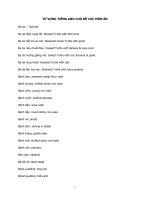Animal rights gail mack (2011) TỪ VỰNG HAY THEO CHỦ ĐỀ
Bạn đang xem bản rút gọn của tài liệu. Xem và tải ngay bản đầy đủ của tài liệu tại đây (5.69 MB, 65 trang )
Animal Rights
ANIMAL RIGHTS
THE ISSUES
Animal Rights
DEBATING
GAIL
MACK
ANIMAL RIGHTS
Copyright © 2012 Marshall Cavendish Corporation
Published by Marshall Cavendish Benchmark
An imprint of Marshall Cavendish Corporation
All rights reserved.
No part of this publication may be reproduced, stored in a retrieval system or transmitted, in any form
or by any means, electronic, mechanical, photocopying, recording, or otherwise, without the prior
permission of the copyright owner. Request for permission should be addressed to the Publisher, Marshall
Cavendish Corporation, 99 White Plains Road, Tarrytown, NY 10591. Tel: (914) 332-8888, fax: (914) 3321888.
Website: www.marshallcavendish.us
This publication represents the opinions and views of the author based on Gail Mack’s personal
experience, knowledge, and research. The information in this book serves as a general guide only. The
author and publisher have used their best efforts in preparing this book and disclaim liability rising
directly and indirectly from the use and application of this book.
Other Marshall Cavendish Offices:
Marshall Cavendish International (Asia) Private Limited, 1 New Industrial Road, Singapore 536196 •
Marshall Cavendish International (Thailand) Co Ltd. 253 Asoke, 12th Flr, Sukhumvit 21 Road, Klongtoey
Nua, Wattana, Bangkok 10110, Thailand • Marshall Cavendish (Malaysia) Sdn Bhd, Times Subang, Lot 46,
Subang Hi-Tech Industrial Park, Batu Tiga, 40000 Shah Alam, Selangor Darul Ehsan, Malaysia
Marshall Cavendish is a trademark of Times Publishing Limited
All websites were available and accurate when this book was sent to press.
Library of Congress Cataloging-in-Publication Data
Mack, Gail.
Animal rights / Gail Mack. — 1st ed.
p. cm. — (Debating the issues)
Includes bibliographical references and index.
ISBN 978-0-7614-4967-6 (print) —ISBN 978-1-60870-662-4 (ebook)
1. Animal rights—Juvenile literature. I. Title. II. Series.
HV4708.M323 2012
179’.3—dc22
2010039298
Editor: Peter Mavrikis
Publisher: Michelle Bisson
Art Director: Anahid Hamparian
Series design by Sonia Chaghatzbanian
Photo research by Alison Morretta
Front cover: IndexStock/Superstock.
Associated Press: Jennifer DeMonte/Daily Inter Lake, 8; Joe Jaszewski/The Idaho Statesman, 9; April L.
Brown, 17; Associated Press, 21, 28; Susan Ragan, 27; John Dearing/Bureau of Land Management, 30;
Steve Parsons, 32; Ted S. Warren, 36; Busch Gardens, Tampa Bay/Press Association, 37; Marcio Jose
Sanchez, 40; Gary Kazanjian, 43. Bridgeman Art Library: The Bridgeman Art Library International, 12.
Getty Images: altrendo images, 6; Mark S. Wexler, 11; Melanie Stetson Freeman/The Christian Science
Monitor, 16; Kim Steele, 19; Daniel J. Cox, 32; Bill Pugliano, 35; Stephane De Sakutin/AFP, 47; Alberto
Simon/AFP, 50; Chris Hondros, 57. Superstock: Frances M. Roberts/Ambient Images, 1, 2-3, 4-5;
image100, 14; age fotostock, 24; IndexStock, 52, 54.
Back cover: age fotostock/Superstock.
Printed in Malaysia (T)
135642
4
Chapter 1 Living Together
Chapter 2 One Side: Animals Should Not
Have Rights
15
Chapter 3 The Other Side: Animals Should
Have Rights
33
Chapter 4 You Decide
53
Glossary
59
Find Out More
61
Index
63
5
Table of Contents
7
From
the earliest times, humans have relied on animals to
perform many kinds of jobs. Dogs help people with disabilities. They
are trained to guide people who cannot see and to alert the hearing
impaired when someone knocks at the door, rings the doorbell, or
calls on the phone. Dogs often work as partners with police officers.
These dogs are trained to sniff out drugs and explosives and to track
criminals. Working dogs living on farms and ranches herd sheep
and cattle. Some breeds serve as watchdogs for property owners and
businesses. Cats also work. On farms, for instance, they are used to
keep barns free of mice.
Humans have also used animals for clothing. Sheep and alpacas provide wool. Minks, rabbits, and other fur-bearing animals are killed for
their pelts. Leather is made from the hides of cattle and other animals—
even crocodiles. Today there are alternatives to using animal fur and
skins. Many fabrics are woven from plants such as cotton and flax.
Humans’ Best Friends
Dogs have lived with humans for more than 14,000 years. It is believed that prehistoric humans fi rst used them as watchdogs and later
A seeing-eye dog guides his blind owner as they walk along a city sidewalk.
1
LIVING TOGETHER
Chapter
ANIMAL RIGHTS
A furry barn cat ignores the antics of its stable pal.
put them to work herding and hunting other animals. The more than
four hundred breeds of dogs that exist today have shown their intelligence, loyalty, companionship, and abilities in many different ways.
Their services include tracking criminals, finding lost persons, sniffing
out illegal drugs and explosives, serving as “eyes” for the blind and
“ears” for the deaf, as well as helping others with a variety of tasks. Socalled therapy dogs are used to cheer up patients in hospitals and nursing homes. Having a dog as a loyal companion may provide health
benefits. Petting a dog, for example, can slow the heart rate and lower
blood pressure.
Cats are smart and independent. Like dogs, they can be playful
and entertaining, and, like dogs, domestic cats have jobs to do. Cats
8
LIVING TOGETHER
can see better in darkness than people can. They climb trees, have
an amazing sense of balance, and can walk along narrow ledges or
fences. They are speedy runners and can leap long distances. When
they fall, they almost always land on their feet. These abilities make
them skillful hunters, especially of mice, rats, and snakes. Although a
cornered cat can be dangerous—it will hiss and scratch with its sharp
claws—cats can also be loving and very patient with little children.
Cats, with their big, glowing eyes, seem mysterious creatures to
many people. The ancient Egyptians believed cats were sacred and
protected their homes. Because of their beauty and grace, cats have
been painted and drawn by many artists throughout the centuries.
Twins Julia and Claire have a sensory muscular disorder, but they have a great time
with Ovelle, a six-year-old Labrador retriever, during feeding therapy at St. Alphonsus
Rehabilitation in Meridian, Ohio.
9
ANIMAL RIGHTS
The Original Horsepowered Engine
Horses, as well as oxen and mules, have been used as beasts of burden—animals that carry heavy packs of tools and supplies and pull
plows, wagons, and carriages. Horses have been hardworking partners
and friends of humans for many years, although in the beginning, early
humans most likely hunted horses for food. However, when people realized how fast and powerful horses are, they learned to ride them to hunt
other animals. Horses have done—and still do—a great variety of jobs.
Horses are especially remembered for their role in delivering the
mail to settlers in the expanding Old West in the nineteenth century.
The Pony Express, an overland mail service that operated from April
1860 to November 1861, carried mail between Saint Joseph, Missouri,
and Sacramento, California. The journey, which took, on average,
ten days, required making regular stops at a network of relay stations
along the 2,000-mile (3,220-kilometer) route for the rider to get a fresh
mount. Among the riders were William F. Cody (who would later become known as Buffalo Bill) and “Pony Bob” Haslam. The Pony Express
ended when the transcontinental telegraph system was completed.
DID YOU KNOW?
In 1861, a wounded Pony Express rider named “Pony Bob” Haslam
rode 120 miles (190 km) from a station at the foot of Lake Tahoe,
in the mountains between California and Nevada, to a station near
Fort Churchill, 75 miles (120 km) to the east, in eight hours and
twenty minutes. His shipment included President Abraham Lincoln’s
inaugural address.
10
LIVING TOGETHER
An Amish farmer and his five horses work together to pull a plow through his field.
From the thirteenth to the eighteenth century, laws that discouraged
acts of cruelty to animals were in effect. However, these laws did not
prohibit animal entertainments such as bearbaiting, cockfighting, and
horse racing or fishing, hawking, and hunting.
In England, the Sunday Observance Act was passed in 1625 under the rule of King Charles I. This law prohibited meetings, assemblies, sports, and pastimes such as bull- and bearbaiting on Sundays.
Two years later, other prohibited Sunday activities were added to this
bill, including travel by horse-drawn carriages and wagons, cattle driving, and the killing of animals by butchers. In 1664, under Charles II,
11
ANIMAL RIGHTS
KING ASHOKA
In the third century
BCE,
Ashoka, king of the Mauryan Empire of India,
established laws that protected animals. Today animal rights activists honor
him not only for creating the first list of “protected” species but also for
declaring what many modern-day activists believe—that animals must not
be slaughtered either for food or for sacrifice.
Ashoka reigned from about 269 to 232
BCE .
At first, he was a fierce
warrior who led many military conquests. After his conquest of the
country of Kalinga, on India’s eastern coast, he was affected by the
suffering the war had caused and renounced armed conquest. At this
time, he adopted Buddhism. His teachings, called edicts, were carved
into rocks and stone pillars.
Ashoka practiced many of the virtues he taught, including compassion,
honesty, truthfulness, and nonviolence to people and animals. He toured
rural areas of India to preach the Buddhist “right way of life” (called dharma)
and to help relieve the sufferings
of the poor.
Ashoka did much to create
a peaceful and just society that
included compassion for animals.
He built hospitals for animals as
well as for people. He banned the
hunting of certain species and
discouraged cruelty to domestic
and wild animals. He also advocated a vegetarian diet.
Detail of a pillar with an engraved edict.
12
LIVING TOGETHER
a law was passed that carried
the death penalty for those
who set fi re to property and
crops or hurt or killed horses,
DID YOU KNOW?
In 1641, the Massachusetts Colony Body of Liberties
passed a law that compelled those driving cattle
long distances to stop and rest animals that were
weary, hungry, or sick.
sheep, or cattle.
In the 1700s, laws were passed that forbade cattle drives through the
cities of London and Westminster. Cattle drivers who mistreated the animals during the drives in the countryside were fined or sent to prison.
WHAT DO YOU THINK?
How did people in earlier times abuse or mistreat animals?
Why did King Charles I and II make laws that stopped animal
abuse on Sundays?
Do you think animals communicate with people? If you do, how
do you think they do it?
If you were making a list of rights for animals, what rights would
you include?
13
Many
people do not believe that animals need or deserve
legal rights. Their belief is based on their opinion that animals are not
enough like humans. For example, do animals feel emotions? Human
emotions include love, fear, joy, sadness, surprise, anxiety, and anger.
People who believe that animals cannot feel emotions do not think
that they are entitled to legal rights. Although people often see human
qualities in animals, regular scientifi c methods cannot prove that
animals feel emotions.
Many people believe that animals merely act—and react—according
to their instincts, and that they lack any ability to think and reason.
Animal Agriculture: Keeping Animals Healthy
Americans spend about $142 billion a year on beef, chicken, pork, turkey, and lamb and eat, on average, about 200 pounds (90 kilograms) of
meat, poultry, and fi sh per person per year. Nearly 10 billion animals
are killed each year. In 2002, the U.S. Department of Agriculture’s Natural Resources Conservation Service reported that there were nearly
2 billion farms and ranches in the United States.
A shopper at a supermarket selects a package of meat.
2
ONE SIDE: ANIMALS SHOULD NOT HAVE RIGHTS
Chapter
ANIMAL RIGHTS
The National Association of State Departments of Agriculture (NASDA) was founded in 1915. The NASDA’s mission is to ensure the wellbeing of animals. Its work includes developing ways to protect animals
from disease-causing germs, called pathogens, so that the germs do not
enter the food chain. Because there is not enough science-based information on what produces a state of well-being in animals, NASDA
members also study ways to improve management practices and systems that will improve animals’ well-being. The NASDA develops public
policy and programs that support and promote the American agricultural industry while protecting consumers and the environment.
THE ANIMAL AND PLANT HEALTH INSPECTION SERVICE
The Animal and Plant Health Inspection Service (APHIS) is a division
of the Department of Agriculture. It works to protect and improve the
health, quality, and marketability of the nation’s animals (including
various wildlife), animal products, and medicinal veterinary products,
such as vaccines. The APHIS also
provides overviews of domestic animal health in the United
States, as well as of the programs
and strategies used to ensure the
animals’ continued health.
The APHIS also includes the
Office of the Chief Information
A quality assurance manager at a
restaurant chain shucks, or opens, an
oyster in order to test it.
ONE SIDE: ANIMALS SHOULD NOT HAVE RIGHTS
Officer of Veterinary Services. This office provides information technology services and delivery to Veterinary Services (VS). The APHIS also
moves quickly to enforce penalties in response to animal welfare violations, including violations of the Animal Welfare Act (AWA) and the
Horse Protection Act (HPA).
ANIMAL AGRICULTURE ALLIANCE
Animal agriculture is essential to preserving America’s security and vitality. The mission of the Animal Agriculture Alliance (established in
1987) is to talk about the importance of modern animal agriculture
to consumers and the media. Using science-based research, the alliance dispenses information on topics ranging from animal welfare
to biotechnology. The alliance also explains how America’s farmers
and ranchers produce the safest and most affordable food in the world
while maintaining high standards of animal well-being.
Chickens gather around their feeders in a poultry house in rural Washington County, Arkansas.
17
ANIMAL RIGHTS
ANTIBIOTICS
Antibiotics are an important tool that farmers and ranchers use to ensure that their animals are both healthy and productive. The Animal
Agriculture Alliance supports the responsible use of antibiotics by
producers. In order to provide the American consumer with a highquality source of protein, farmers and ranchers follow herd and flock
health-management programs designed to keep their animals healthy.
Antibiotics must go through a complicated, diffi cult approval process
before being approved by the U.S. Food and Drug Administration
(FDA). Many farmers, veterinarians, and lawmakers agree that these
medicines help producers provide safe, affordable food.
CALIFORNIA’S EARLY-WARNING SYSTEM
California protects both livestock and consumers with the California
Animal Health and Food Safety (CAHFS) Laboratory System, which is
responsible for making swift diagnoses of animal diseases affecting humans. It partners with California’s Department of Food and Agriculture
at the Davis campus of the University of California and with veterinarians and livestock and poultry producers.
Medical Testing Using Animals
Animals are used for medical testing because it is necessary and
benefi ts humans. The goal is to experiment with new medicines and
vaccines fi rst on animals to see how the medicines affect them before doing human studies. Throughout the world about 50 million to
18
ONE SIDE: ANIMALS SHOULD NOT HAVE RIGHTS
These caged rabbits are used as test subjects for antibody production in a research facility in India.
100 million vertebrate animals, from zebra fish to monkeys, chimpanzees, and other vertebrates, are used in experiments every year. Mice,
rats, birds, fish, frogs and other animals, however, are not included in
this figure. Some 80 million mice and rats were used in experiments in
the United States in 2001. Animals used in experiments are usually euthanized afterward. There are several sources of research animals. Most
are bred for use in experiments; others are caught in the wild or bought
from dealers who get them at auctions or from animal pounds.
Different countries regulate the use of animals in different ways.
Those that support using animals for experiments argue that nearly
every twentieth-century medical achievement used animals in various
19
ANIMAL RIGHTS
Where Is Testing Done and for What
Kinds of Research Are Animals Used?
WHERE
KINDS OF RESEARCH
OTHER
Universities and
medical schools
Defense contractor
laboratories
Pharmaceutical companies
Commercial laboratories
and other facilities
Farms
Biomedical
Genetics
Behavioral studies
Developmental biology
Xenotransplantation
Drug testing
Toxicology
Cosmetics testing
Education
Breeding
Defense research
ways. Supporters of animal use insist that computers cannot model the
ways in which different things might interact during a test.
Victory over Polio
In 1921, outbreaks of polio (poliomyelitis) swept through the United
States. Polio, an infectious viral disease, has been around since ancient
times. Polio attacks the nerve cells and sometimes the central nervous
system and usually causes paralysis and sometimes even death. Its early
symptoms are like those of the flu. Polio strikes mostly children, but
adults can also be infected. Polio struck Franklin D. Roosevelt (who later
became a U.S. president) just a few days after he had gone swimming
during a family vacation in 1921. Roosevelt thought he had developed a
cold—but it was polio. His legs were left permanently paralyzed.
20
ONE SIDE: ANIMALS SHOULD NOT HAVE RIGHTS
In the 1940s, Dr. Jonas Salk used
rhesus monkey cross-contamination
studies to isolate the three forms of
the poliovirus that affected hundreds
of thousands yearly. Salk’s team created a vaccine against the strains of
polio in cultures of monkey kidney
cells. In 1952, the United States suffered an outbreak of 58,000 polio
cases, and in the following year
35,000 cases. The Salk vaccine,
which used dead viruses, was made
publicly available in 1955 and reduced the number of polio cases
fifteenfold in the United States over
In the 1950s, Dr. Jonas Salk, first to develop a polio
vaccine, holds aloft bottles containing a culture
used to grow the vaccine.
the following five years. Dr. Albert Sabin made a superior “live” vaccine by passing the poliovirus through animal hosts, including monkeys. His oral vaccine (the doses are taken by mouth) was produced
DID YOU KNOW?
Mold, a woolly growth, usually fungal in origin, often appears in damp
areas or on foods. In 1928, Alexander Fleming, a British scientist,
noticed mold growing on a germ-culture medium. The mold, Penicillium
notatum, had ruined the culture. Ten years later, scientists isolated an
antibacterial molecule in the mold, which they named penicillin. Since
then, many different forms of penicillin have been developed to treat a
wide range of diseases.
21
ANIMAL RIGHTS
for public use in 1963 and is still in use. It had virtually stamped out
polio in the United States by 1965. An estimated 100,000 rhesus
monkeys were killed in the course of developing the polio vaccines;
sixty-five doses of vaccine were produced from each monkey. The
two vaccines have wiped out polio in most countries throughout the
world. The worldwide number of cases dropped from about 350,000
cases in 1988 to 1,652 cases in 2008.
SARS
SARS (severe acute respiratory syndrome) is an illness that affects the
lungs and breathing and can lead to pneumonia. It is caused by a
SARS-related coronavirus (SARS-CoV). The first outbreak was reported
in Asia in February 2003. Over the next few months, SARS spread to
more than two dozen countries in North America, South America, Europe, and Asia before it was contained.
The World Health Organization (WHO) has reported that 8,098 people worldwide became sick with SARS in the 2003 outbreak. Of these,
774 died. In the United States, only eight people caught the infection—
all had traveled and been exposed to the SARS virus in other parts of the
world. The disease did not spread widely in the United States.
SARS seems to spread mainly through close contact: hugging, kissing, sharing eating or drinking utensils, touching someone, or talking
to someone a few feet away or closer. You cannot catch it just from
walking past someone or sitting across from someone in a large waiting room or office.
22
ONE SIDE: ANIMALS SHOULD NOT HAVE RIGHTS
SYMPTOMS OF SARS
Generally, SARS begins with high fever—that is, a
temperature higher than 100.4 degrees Fahrenheit
The SARS virus hitches a ride on droplets that
spread when an infected
(38.0 degrees Centigrade). Fever is followed by
person sneezes or coughs.
• mild respiratory symptoms
Droplets can fl y about 3
• headache
feet (1 meter) through the
• overall feeling of discomfort
air and land on or in the
• body aches
mucous membranes of a
• diarrhea (10 to 20 percent of patients)
• dry cough (after two to seven days)
nearby person’s mouth,
• pneumonia
nose, or eyes. A person
may also catch the disease
by touching a surface or object that contains the infectious droplets
and then touching his or her nose, mouth, or eyes. The virus may also
spread by other yet unknown ways.
Researchers found that a new coronavirus never seen in humans
was the cause of SARS. In experiments at a medical center in Rotterdam, the Netherlands, researchers infected monkeys with the new
coronavirus. The monkeys developed a lung disease exactly the same
as SARS.
Ultimately, a SARS vaccine was developed. A federal health agency,
the Centers for Disease
Control (CDC), was, as of
DID YOU KNOW?
2011, continuing to work
More than 95 percent of the SARS cases took place
in twelve countries or areas in the World Health
Organization’s Western Pacific Region.
with other federal agencies, state and local health
23
ANIMAL RIGHTS
departments, and other health-care organizations to plan for rapid recognition of and response to the disease should it ever come back.
Protections for Lab Animals
Today in the United States, researchers must follow certain laws and
regulations, both federal and state. A federal law, the Animal Welfare
Act of 1966, requires adequate food and shelter for certain kinds of lab
animals. The National Institutes of Health, a federal agency, requires
each institution it funds to establish a committee to oversee the use and
care of the animals.
In the United States, scientists experiment on more than 20 million animals a year, although animal rights advocates estimate that
as many as 100 million animals—90 percent of which are mice and
rats—are used as subjects in biological, medical, and psychological
studies. In addition to mice and
rats, researchers also use birds,
cats, dogs, guinea pigs, hamsters,
monkeys and other primates, and
rabbits. Educators use animals to
teach students anatomy, physiology, biology, and surgery.
Medical researchers study animals to learn about their body processes and how they relate to those
A student dissects a frog in biology class.
of humans. Researchers also use
24









